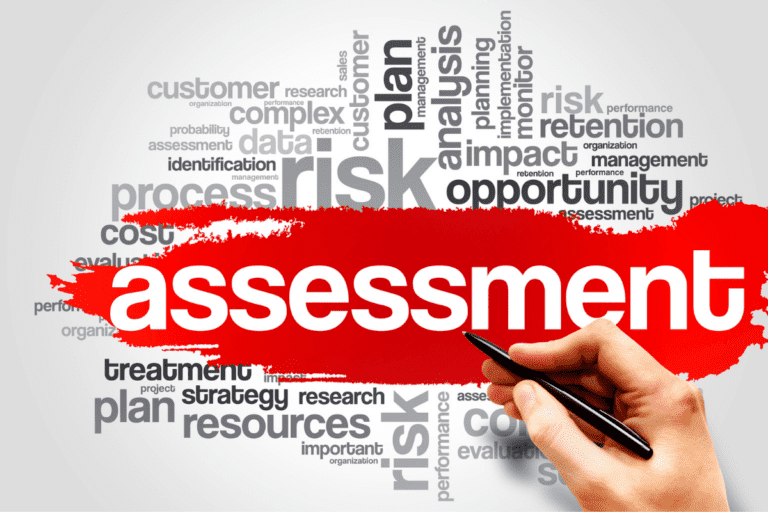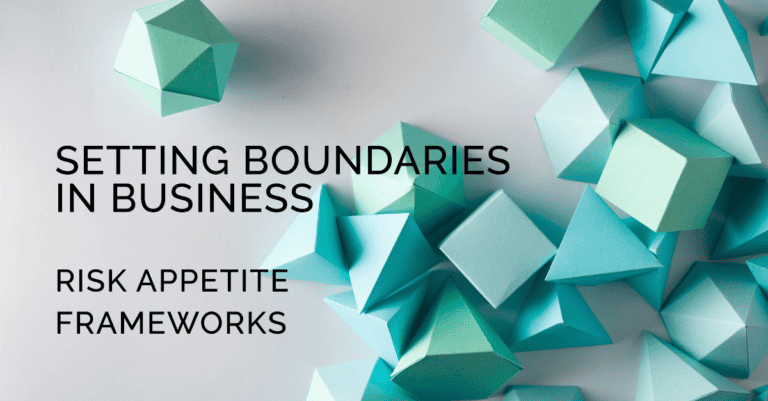What is a risk management plan? A plan to identify, assess, evaluate, control, mitigate, and monitor risk.
Risks are an inherent part of any business.
Within this post, the term risk covers both negative risks (threats) and positive risks (opportunities)
Some risks are unavoidable, such as executing a business delivery over the holidays and planning the timeline around them.
However, risks can surprise the business and management team if they’re not managed properly.
For example, businesses can unwittingly create operational risks by not asking enough questions about potential problems before taking on new projects or clients. They can also unintentionally create risks by neglecting critical areas of their operations or failing to keep up with technological advances.
By understanding the different types of risks a business faces, strategies can be implemented to minimise their impact and prevent problems from happening in the first place.
That’s where risk management planning comes in – to help control and mitigate a potential risk event before it becomes an issue.
But first, what is risk management?
What is Risk Management?
Risk management is critical to any business. It’s the process of planning and assessing existing risks so they can be minimised (risk threat), maximised (opportunity) or eliminated.
Good risk management practices help companies avoid potential problems and protect their assets.
Without risk management, businesses could face legal action, revenue loss, or even bankruptcy.
Managing risk is an essential part of any successful business.
The risk management process has these five main steps:
- Risk Identification: The first step to managing risk is identifying potential events. Use data sources that can accurately estimate potential risks impacting the business. This will help make informed decisions about how to control and mitigate those risks
- Risk Analysis: Following risk identification, the organisation should determine its exposure to each identified risk and how it could influence its operational goals. The objective of this analysis is to understand the potential consequences of each identified risk on the organisation’s ability to achieve its strategic and tactical objectives
- Risk Assessment and Evaluation: The risks associated with a potential risk are carefully evaluated and weighed before a decision is made on whether it is allowable for the organisation to take on the risk. Its likelihood of occurrence and impact on the organisation is considered to determine if a risk is acceptable. Once it has been decided that taking on the risk is something that the organisation is willing to do, a plan for controlling and mitigating any potential damage is put into action
- Risk Control and Risk Mitigation: It’s time to create a risk management plan. While defining which business or project team members will be responsible for monitoring, controlling and mitigating risks, it is also essential to consider a contingency plan in case of any unforeseen events
A risk management plan is essential to keeping a business safe and protecting assets. It’s a proactive and reactive process that helps organisations stay safe and thrive throughout the business life cycle. Creating a constantly updated plan to account for emerging risks is also essential.
Risk Management Planning

A risk management plan outlines the steps the business takes to control and mitigate potential risks. This includes using funds, tools, and strategies to identify, assess, control, and monitor risks.
A risk management plan usually includes the following:
- Methodology: tools and approaches for risk management can vary depending on the organisation or business. Generally, a risk assessment will be performed to identify potential risks and vulnerabilities, while risk analysis will help determine the level of risk and how to control and mitigate it
- Risk Register: a risk register is a table that will document all the potential risks associated with a business. This table can help make decisions to protect the company and its stakeholders from potential harm
- Risk Hierarchy Structure: a risk chart that identifies risk categories and the hierarchical structure of risks. This will help understand where the business is at risk and where there needs to be focussed management of those risks
- Risk Matrix: a risk matrix allows visual analysis of the likelihood and the impact of risks so they can be prioritised
- Risk Response: a risk response is a management plan that explains the risk control and mitigation strategy that will be employed to manage risk
- Roles and responsibilities: there should be risk owners; these can be risk management team members or others with the appropriate resources and authority. They need to monitor risks and supervise their risk response actions
- Budget: A section where the funding has been identified to perform the risk management activities
- Timing: Include a section to define the schedule for the risk management activities

How to Make a Risk Management Plan
There are always risks in running a business. That’s just the nature of business. But that’s also why it’s crucial to have an integrated risk management plan to identify and address potential problems before they become significant.
The steps to creating a risk management plan are outlined below:
1. Risk Identification
- Brainstorm for defining risks that could affect the business and create a list of possible solutions
- Develop risk control and risk mitigation strategies for each risk on the list, prioritising those that would be the most influential risk minimisation measures
- Implement strategies as needed to reduce the likelihood of encountering risks during normal operations
- Monitor results regularly and adjust the plan as necessary to maintain business stability and security
- Creating and implementing a risk management plan is an integral part of managing any business, but it’s even more crucial to avoid potential disasters
- Risk identification starts at the beginning of the business risk planning phase and throughout the life cycle. While many risks are considered “known”, others might require additional research to discover
Many risks can be divided into categories, like cost or schedule, and listed by specific categories like technology, interfaces, performance, logistics, HR, department, client, etc.
Create a risk hierarchy to identify and classify all risks into risk categories. Interview all stakeholders and industry experts to do this.
A risk register will also be created to share with all stakeholders in a centralised location and provide the details of all known risks revealed during the identification phase.
A business can create a risk register using online risk management software. Files can be attached, and progress can be monitored better than with to-do list apps or Excel files. For example, use the table view on GetRiskManager to capture all risks, add their priority level, and assign a team member to identify and resolve them. Then, you can see the status of the work on resolving the issue.
Keep risks from derailing the business by signing up to GetRiskManager.
2. Risk Analysis
When you have all the known risks, it’s time to start analysing them. To identify potential risks, categorise them according to their likelihood and impact on the business.
There are many ways of categorising risks. One way is to consider risk as a relative measure, e.g., low, medium, or high. Another way is to consider risk as an absolute measure, e.g., chances of occurrence, financial or public relations impact. There are also numeric measures of risk, such as the Controlled Risk-rating System (CRS) or Probability and Impact Factor (PIF), which offer a comprehensive view of risk management.
Once the categories and risk measures are identified, it’s time for the analysis phase. In this phase, the most critical risks for the business will be determined. Do this by interviewing all stakeholders and industry experts. Then, the risk register will be updated and shared with everyone interviewed and stakeholders for a centralised location of all known potential risk events.
Once the risks most important to the business are determined, it’s time to assess their potential likelihood and impact on the company. This will help decide how significant each risk is for the business and what actions must be taken to control and mitigate its effects.
3. Risk Assessment and Evaluation

In the assessment and evaluation phase, review the qualitative and quantitative impact of the risk, such as the probability of the risk event occurring versus the impact it would have on the business. Then, map out a risk matrix, also known as a risk assessment matrix.
First, assign the risk likelihood a score from remote to highly probable. Then, the risk impact is defined from insignificant to extreme, and each risk is assigned a score—the function of the probability and impact. This is provided automatically within GetRiskManager. The score will show how likely the potential risk event will impact the business’s success and how urgent the control and mitigation response needs to be.
4. Risk Response Planning
Risk response is the action plan to manage risks before they occur. The risk response plan includes the risk control and risk mitigation strategy to address the impact of risks in the business. Doing this usually comes with a cost. So, allocate time and money for implementation before creating the risk management plan.
5. Assigning Risk Owners
To help manage risk effectively, assign each risk a responsible risk owner. These individuals will be responsible for monitoring the risks and ensuring that appropriate action is taken before risks are realised.
When creating the risk register and risk assessment matrix, list the individuals responsible for mitigating risks so that everyone knows who will need to take action before the risk becomes an issue.
Ensure all business or project stakeholders have approved the plan to address those risks. This will allow you to track progress and revisit any issues as they arise.
6. Understand Triggers
Suppose risks have already impacted the business. In that case, re-evaluate them to ensure they are controlled and mitigated further.
Even if the conditions for a particular risk have not been met, it is best to devise a contingency plan.
7. Contingency Planning
It’s essential to have a contingency plan in place as part of the process to prepare for any changes.
8. Risk Appetite
Risk appetite can be determined by consulting stakeholders and determining if the risk level is too high. If it’s determined that the level of risk is too high, it may not be worth continuing with a specific project risk or changing its scope.
The risk appetite is typically determined by considering risks with a “very high” score or more than a few “high” scores. Additional consultation is required if the business may be at risk of failure.
Managing risks is integral to running a business; software like GetRiskManager can help monitor them. The GetRiskManager dashboard includes tools to calculate the business’s health, identify potential problems early on, and help decide how best to address them.

Maintaining a Risk Management Plan: Best Practices
Risk management plans should be rigorously followed, lest they become ineffective over time.
Successful risk management relies on a well-functioning process and accurate risk modelling. Without these components, plans may fail due to incremental changes or because risks were not adequately considered.
The best practice for the risk management process is to continuously evaluate and reevaluate risks throughout their life cycle, focusing on the monitoring phase. This will help ensure that emerging risks are appropriately assessed and managed.
One way to monitor the risk management plan is to use dashboards and other risk-tracking features. This can help stakeholders stay informed about business risks and decide how to manage them.
Review risk management processes regularly to ensure the business complies with regulatory requirements. This includes interviewing the same stakeholders and revisiting the same risks.
How GetRiskManager Can Help With the Risk Management Plan

Risks can be a big concern for businesses.
With GetRiskManager, you can use collaborative workspaces to resolve risks faster and easier than ever. Scheduling and task tools can identify risks and assign risk owners. You’ll also have complete visibility into which tasks are assigned to which team members and real-time access to see how they address those risks. Marking risks as done will archive them for later reference.
GetRiskManager excels at monitoring risks. It makes it easy to create reports quickly, so you always have the information needed to take appropriate action when risk conditions are met.






